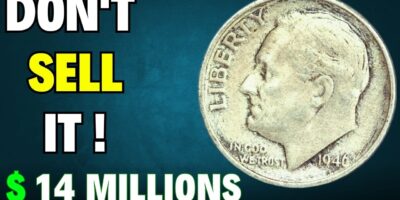The 1953 Penny: An In-Depth Look at Its Value
The 1953 penny, a small yet significant piece of U.S. currency, carries with it a slice of American history. Minted over 70 years ago, these coins are a part of the Lincoln Wheat series, a type long favored by collectors and historians alike. But what exactly determines the value of a 1953 penny today? Let’s explore the nuances that contribute to its worth.
Understanding the 1953 Penny
The 1953 penny is made of 95% copper and 5% zinc, typical of coins from this era. It’s classified under the Lincoln Wheat series, which was minted from 1909 to 1958. The obverse features the iconic bust of Abraham Lincoln, designed by Victor David Brenner, while the reverse displays two wheat ears, a signature of wheat pennies.
Mint Marks and Their Influence
1953 pennies were minted in three locations: Philadelphia, Denver, and San Francisco, each leaving its own mint mark—except Philadelphia, which traditionally did not use them at the time. The presence or absence of these mint marks, located below the date on the obverse side, significantly affects a coin’s value.
- Philadelphia (no mint mark): The most common, with over 256 million minted. Lack of a mint mark generally means the coin is less rare.
- Denver (‘D’ mint mark): Around 700 million minted, making these less rare but can still hold value, particularly in better conditions.
- San Francisco (‘S’ mint mark): About 181 million S mint pennies were made. These tend to be more sought after due to their relative scarcity.
Grading Condition and Its Impact on Value
The condition of a coin directly impacts its value. The Sheldon coin grading scale, ranging from Poor (P-1) to Mint State (MS-70), is used to assess the condition of a penny.
For lower-grade coins, common signs of wear include flattened details and lack of luster. These may circulate for decades but contribute only a small amount over their face value. In contrast, higher-grade coins showcase sharp details and retain much of their original mint luster, appealing to serious collectors.
Error Coins: Unexpected Treasures
Error coins can form when mishaps occur during minting. These anomalies may include off-center strikes, double dies, or planchet errors, each unique and potentially raising a penny’s value considerably. In particular, double die pennies from any year can command higher prices, given their fascinating deviations from the norm.
Sourcing and Setting Value
The sourcing of a 1953 penny might originate from a coin dealer, online marketplace, or a family heirloom. When setting its value, factors such as metal content, mint mark, condition, and wear come into play. While most 1953 pennies hold minimal additional value over face value, exceptions exist, especially for uncirculated coins and error varieties.
The Market for 1953 Pennies
High-quality 1953 pennies, especially those in uncirculated condition, are in demand among numismatists. Prices can vary from a few dollars to higher figures, depending on rarity and error presence. The enduring allure of collecting penny rolls from the early 1950s further emphasizes collectors’ fascination with this period.
Preserving the Value
Maintaining or enhancing a 1953 penny’s condition requires proper storage. Coins should be stored in a dry, cool place, away from environmental contaminants. Using coin holders, albums, or folders can prevent physical damage and corrosion.
Avoid cleaning old coins, as inappropriate methods can reduce their numismatic value. Marks or changes caused by cleaning can diminish their originality, an aspect prized in numismatic circles.
Historical Significance in Numismatics
Numismatics, the study of coins and currency, finds significant interest in the years following World War II. The 1953 penny, amidst economic growth and post-war adjustments, stands on the brink of a changing America. Coins from this time provide insights into the techniques and politics of U.S. mints.
The subtle shifts in design and production during this era reflect broader societal changes. Thus, each 1953 penny represents a time capsule, capturing a moment in the nation’s rich monetary history.
Collecting Strategies for Enthusiasts
For those interested in acquiring or collecting 1953 pennies, focus on the coin’s story—its origin, condition, and any unique characteristics. Building a collection around the various mint marks can provide a deeper appreciation of mint histories and production dynamics. Consider seeking out certified coins from reputable grading companies to ensure authenticity and quality.
Engage with local coin clubs or online communities to gain insights and share experiences. These platforms often serve as a treasure trove for budding numismatists, providing both educational resources and trade opportunities.
Conclusion: The Ongoing Appeal of the 1953 Penny
While financially modest for most, the 1953 penny holds intrinsic value in the narrative of American numismatics. Its worth is determined not just by economic factors but by a connection to a period of transformation and growth. Whether you’re a seasoned collector or a curious enthusiast, the 1953 penny offers a tangible link to a bygone era.

